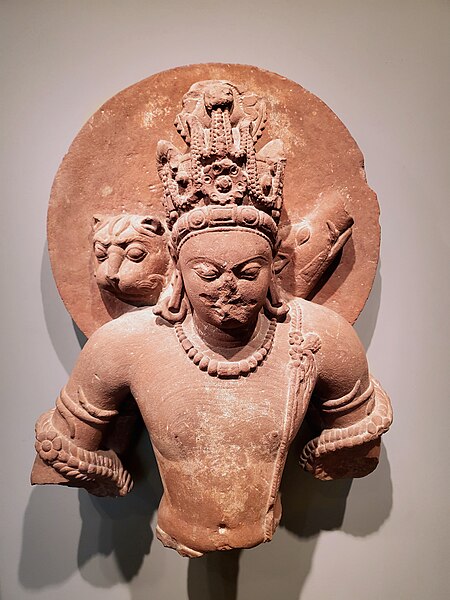Narasimha, sometimes rendered Narasingha, is the fourth avatar of the Hindu god Vishnu. He is believed to have incarnated in the form of a part-lion, part-man being to kill Hiranyakashipu, to end religious persecution and calamity on earth, thereby restoring dharma. Narasimha is often depicted with three eyes, and is described in Vaishnavism to be the God of Destruction; he who destroys the entire universe at the time of the great dissolution (Mahapralaya). Hence, he is known as Kala (time) or Mahakala (great-time), or Parakala in his epithets. There exists a matha (monastery) dedicated to him by the name of Parakala Matha at Mysuru in the Sri Vaishnava tradition. Narasimha is also described as the God of Yoga, in the form of Yoga-Narasimha.
Sculpture of Narasimha in Tirumala, India
Vishnu and his avataras (Vaikuntha Chaturmurti): Vishnu present as Krishna as a human , Narasimha as a lion, Varaha as a boar. Art of Mathura, mid-5th century CE. Boston Museum.
Narasimha, 5th century, Ramtek Kevala Narasimha temple.
Narasimha Disemboweling Hiranyakashipu, manuscript folio from a Bhagavata Purana, 1760-1770.
Avatar is a concept within Hinduism that in Sanskrit literally means 'descent'. It signifies the material appearance or incarnation of a powerful deity, or spirit on Earth. The relative verb to "alight, to make one's appearance" is sometimes used to refer to any guru or revered human being.
Hindu god Vishnu (centre) surrounded by his ten major avatars, namely Matsya; Kurma; Varaha; Narasimha; Vamana; Parashurama; Rama; Krishna; Buddha, and Kalki
Mohini, the female avatar of Vishnu (statue at Belur temple, Karnataka.)
Sharabha (right) with Narasimha (18th-century painting, Pahari/Kangra School)
Jhulelal, incarnation of Varuna







